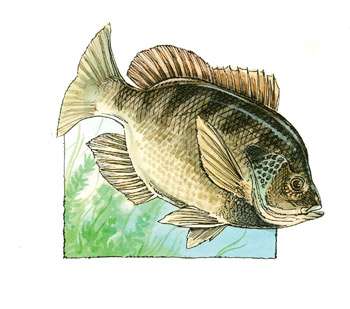
No one is more concerned about bass than bass fishermen. And since we are intensely interested in these gamefish, we should be concerned with every aspect of their lives if we are to be successful anglers. The more we know about them, the better off we'll be. Topping the list of pertinent information is what bass' most common prey is. There are lots of variables that determine what the most common forage is — things like geographic location, time of year, type of water, the list goes on.
In this series on bass forage, we will analyze the most common bass foods in an attempt to help you become a better angler through a better understanding of bass' diet. Even a rudimentary knowledge of what your crankbait is imitating and why will go a long way in the development of your angling proficiency.
This first installment features one of the bass' most prevalent and abundant prey, the sunfishes. Sunfishes are found in nearly every body of water that holds bass, and they have many of the same habits that bass do — after all, the bass are simply the largest members of the sunfish family. These hearty fish will be at the top of the list for hungry bass because of their almost parallel existence. There are variances among the species of sunfish depending on where you are geographically, but the fish behaviors and appearances will remain much the same.
Gene Gilliland, the Central Region Supervisor for Oklahoma Department of Wildlife Conservation, has an intricate knowledge of bass and their prey. Gilliland acknowledges the sunfishes, which include bluegill, other sunfish varieties and bass themselves, are a mainstay of the bass' diet.
"Where sunfish are the most prevalent form of forage, they can account for up to 75 percent of bass' diet," he says "But, that is also true of the most abundant forage for any body of water. Whatever is there in the greatest number will naturally get eaten the most."
As sunfish evolved, they have done so alongside bass, Gilliland says, so they have many of the same seasonal habits and movements. They spawn, however, slightly later than bass in the spring to early summer, leaving easy prey for fingerling bass. Sunfishes prefer cover and structure as well and spawn in many of the same places as bass — on gravel flats or sandy shallows, whichever is available. Sunfish also go deep during the day to eat things that live on the bottom, with the bass close behind. They are typically found from the surface down to twenty feet, and geographically most everywhere there is fresh water.
The fish that are most likely to be eaten by keeper bass are between 1 and 6 inches in length. "Sunfish" encompasses many subcategories, but most popular among them is the bluegill.
The appearance of sunfish is much the same over each subspecies. There simply isn't a lot of variation in different locales. According to Gilliland, to best match a bluegill pattern, look for bluish green baits with dark vertical bars, especially in crankbaits. Gilliland also notes that spinnerbaits in the more "attracting" colors, chartreuse and white specifically, are also effective sunfish imitators. Gilliland says that matching your local hatch of sunfish is not as important as one might think. Jigs are also good baits to bet on in imitating bluegill.
"Bass are really indiscriminate at times concerning their diet," he says, "A lot of the time it's 'eat first, ask questions later.' Just getting your bait in proximity of a feeding bass is more important than having just the right coloration or pattern."
Since bluegill and sunfish are so abundant and so often eaten by bass, anglers would be wise to carry numerous baits imitating these baitfish. However, this is only half of the equation; knowing sunfish's haunts and habits allow anglers to better capitalize on their relationship with bass.




